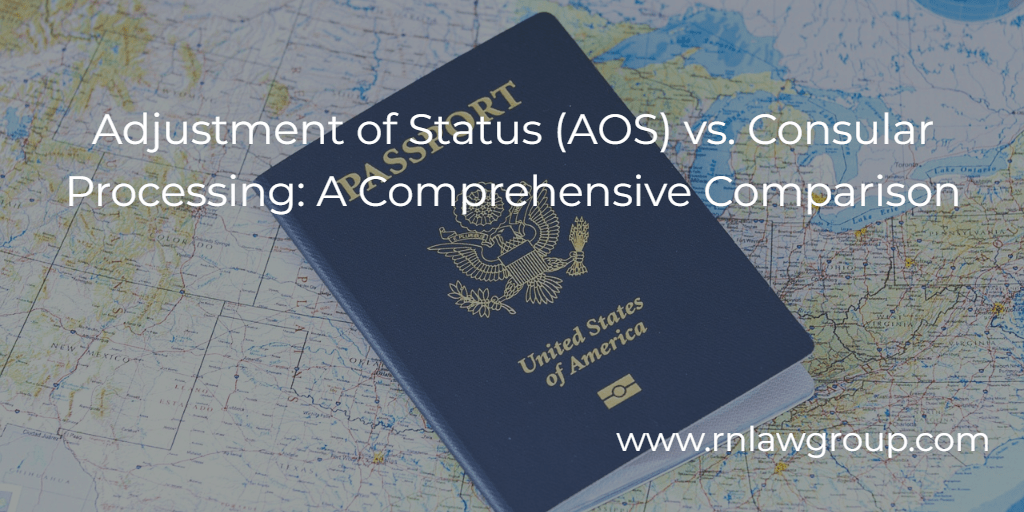
Adjustment of Status (AOS) vs. Consular Processing: A Comprehensive Comparison
Adjustment of Status (AOS) and Consular Processing represent two separate methods for individuals seeking to attain lawful permanent residency in the United States. Although both methods ultimately result in obtaining a Green Card, they differ significantly in various aspects, including the location of the application process, the duration of processing, and the associated risks. It is essential for anyone contemplating permanent residency in the U.S. to comprehend these distinctions.
Adjustment of Status (AOS) is intended for individuals who are already in the U.S. under a valid nonimmigrant status, such as a student visa (F-1), work visa (H-1B), or visitor visa (B-2). This process enables these individuals to shift to permanent residency without departing the country. Typically, AOS is filed alongside other petitions, such as family-based or employment-based immigrant petitions (for instance, Form I-130 for family sponsorship or Form I-140 for employment-based applications). Once the application is submitted, the individual is generally permitted to remain in the U.S. while awaiting processing, and in certain situations, they may qualify for work authorization and advance parole (permission to travel) during this period.
Conversely, Consular Processing is applicable to individuals applying for permanent residency from outside the U.S., or to those within the U.S. who opt not to pursue or are ineligible for AOS. In this case, the applicant must go through the U.S. embassy or consulate in their country of origin. Following the approval of the immigrant petition by the U.S. Citizenship and Immigration Services (USCIS), the case is forwarded to the National Visa Center (NVC), which handles the application before arranging an immigrant visa interview at the consulate. If the interview is successful, the applicant is issued an immigrant visa to enter the U.S., where they will be granted permanent residency upon arrival.
The primary difference between Adjustment of Status (AOS) and Consular Processing lies in the applicant’s location during the procedure. AOS is performed entirely within the United States, whereas Consular Processing necessitates that the applicant be outside the United States for a portion of the process. This distinction can significantly affect factors such as timing, travel limitations, and the ability to work while the application is being processed. Applicants utilizing AOS can apply for an Employment Authorization Document (EAD) and advance parole after submitting their applications, which permits them to work and travel while awaiting a decision. Conversely, those undergoing Consular Processing typically cannot work in the United States until they enter with their immigrant visa and finalize the necessary steps.
Additionally, the level of risk associated with each process differs. AOS provides a considerable advantage for individuals already present in the United States. In the event of a denial, applicants may have certain rights to appeal and, in some instances, may be permitted to remain in the country while exploring alternative immigration options. In contrast, Consular Processing presents a greater risk; if a visa is denied during the consular interview, the individual is usually left outside the United States with limited options to contest the decision. This aspect makes AOS particularly attractive for those concerned about the possibility of denial or complications in their application process.
The primary difference between Adjustment of Status (AOS) and Consular Processing lies in the applicant’s location during the procedure. AOS is performed entirely within the United States, whereas Consular Processing necessitates that the applicant be outside the United States for a portion of the process. This distinction can significantly affect factors such as timing, travel limitations, and the ability to work while the application is being processed. Applicants utilizing AOS can apply for an Employment Authorization Document (EAD) and advance parole after submitting their applications, which permits them to work and travel while awaiting a decision. Conversely, those undergoing Consular Processing typically cannot work in the United States until they enter with their immigrant visa and finalize the necessary steps.
Additionally, the level of risk associated with each process differs. AOS provides a considerable advantage for individuals already present in the United States. In the event of a denial, applicants may have certain rights to appeal and, in some instances, may be permitted to remain in the country while exploring alternative immigration options. In contrast, Consular Processing presents a greater risk; if a visa is denied during the consular interview, the individual is usually left outside the United States with limited options to contest the decision. This aspect makes AOS particularly attractive for those concerned about the possibility of denial or complications in their application process.
Cost is a significant consideration that can affect an applicant’s choice. The fees associated with Adjustment of Status (AOS) are typically higher than those for Consular Processing, particularly when including the extra costs for work authorization and advance parole applications. Nevertheless, the expenses related to travel for Consular Processing, which may involve waiting abroad for a visa interview, can mitigate this cost difference for certain applicants. Furthermore, the indirect financial implications of being unable to work during the Consular Processing period may render AOS a more appealing option for individuals who require a steady income.
Regarding eligibility, not all foreign nationals residing in the U.S. are eligible for Adjustment of Status. To qualify for AOS, individuals must have entered the U.S. legally, which entails being inspected and admitted or paroled into the country. There are limitations for those who have overstayed their visas or breached the terms of their status. While certain waivers may be accessible, these circumstances can complicate the application process. Conversely, Consular Processing does not necessitate lawful entry into the U.S., as the entire procedure occurs overseas. This aspect makes it an appealing choice for individuals who may not meet the criteria for AOS due to immigration infractions or those who entered the country without authorization.
A significant benefit of Consular Processing is that it circumvents some of the backlogs frequently associated with Adjustment of Status. USCIS processing centers can become overwhelmed, resulting in delays, especially in high-demand immigration categories. In contrast, Consular Processing, particularly in nations with lower demand for U.S. visas, may lead to quicker approval times. However, this benefit is often offset by the requirement for the individual to attend an in-person interview abroad, which may involve travel-related challenges or complications, particularly during periods of global travel restrictions.
When evaluating family members, both processes can include derivative beneficiaries, such as spouses and children. In the Adjustment of Status (AOS) process, derivative beneficiaries submit their own adjustment applications concurrently with the primary applicant. Conversely, in Consular Processing, derivative beneficiaries have the option to apply simultaneously with the primary applicant or to follow at a later date. Both pathways enable family members to secure permanent residency; however, family-based AOS petitions may experience delays if there are additional security or eligibility issues.
Moreover, it is crucial to take into account the individual circumstances that may influence the choice between AOS and Consular Processing. AOS is typically a more convenient route for those already residing in the United States, particularly if they have established employment, housing, and community ties. This option allows them to remain in the country and, in most instances, continue their daily lives with minimal interruption. On the other hand, Consular Processing might be more suitable for individuals who are outside the U.S. or for those currently in the U.S. who are ineligible for AOS due to previous immigration infractions. Additionally, some applicants may prefer to finalize the process outside the U.S., especially if they need to return to their home country for personal or professional obligations.
In summary, the decision between Adjustment of Status and Consular Processing is influenced by several factors, such as the applicant’s current residence, eligibility criteria, and individual preferences. Although both methods ultimately result in obtaining lawful permanent residency, the experiences associated with each can differ significantly. Adjustment of Status offers a more efficient route for individuals already present in the United States, along with the advantage of obtaining work and travel authorization during the application process; however, it may involve longer wait times and higher costs. Conversely, Consular Processing serves as a suitable alternative for applicants located outside the U.S. or those who do not qualify for Adjustment of Status, typically featuring quicker processing times but carrying the potential risk of denial while outside the country. Each option presents its own set of advantages and disadvantages, making it crucial to thoroughly evaluate one’s specific situation and objectives before making this significant choice.
By: Karim Jivani
Karim Jivani is an Associate Attorney at Reddy Neumann Brown PC who focuses on employment-based non-immigrant visas. Karim’s practice covers all phases of the EB-1A and EB-2 NIW visa process including filing petitions, responding to Requests for Evidence (RFE), and drafting motions and appeals. Karim has also worked on all aspects of H-1B, L-1, I-140, and VAWA petitions.

